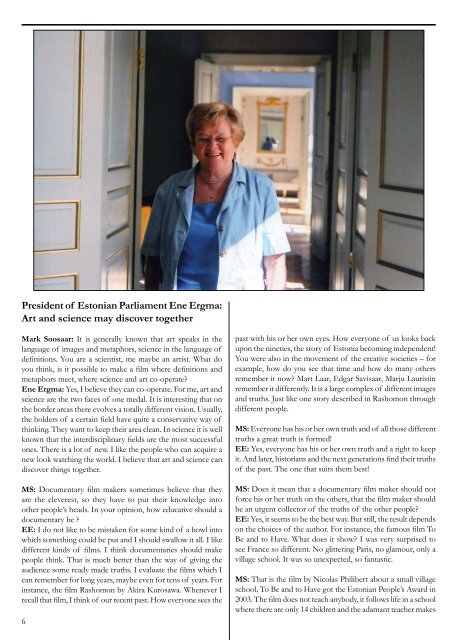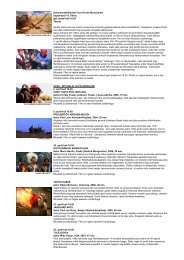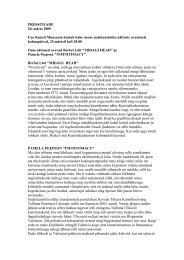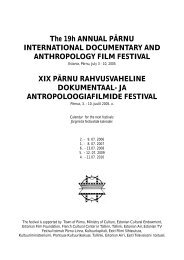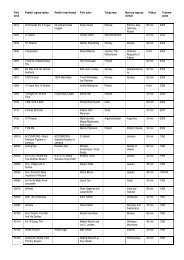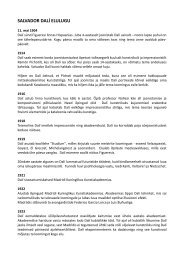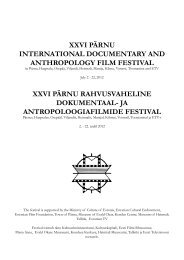xxii pärnu international documentary and anthropology film festival ...
xxii pärnu international documentary and anthropology film festival ...
xxii pärnu international documentary and anthropology film festival ...
Create successful ePaper yourself
Turn your PDF publications into a flip-book with our unique Google optimized e-Paper software.
President of Estonian Parliament Ene Ergma:<br />
Art <strong>and</strong> science may discover together<br />
Mark Soosaar: It is generally known that art speaks in the<br />
language of images <strong>and</strong> metaphors, science in the language of<br />
definitions. You are a scientist, me maybe an artist. What do<br />
you think, is it possible to make a <strong>film</strong> where definitions <strong>and</strong><br />
metaphors meet, where science <strong>and</strong> art co-operate?<br />
Ene Ergma: Yes, I believe they can co-operate. For me, art <strong>and</strong><br />
science are the two faces of one medal. It is interesting that on<br />
the border areas there evolves a totally different vision. Usually,<br />
the holders of a certain field have quite a conservative way of<br />
thinking. They want to keep their area clean. In science it is well<br />
known that the interdisciplinary fields are the most successful<br />
ones. There is a lot of new. I like the people who can acquire a<br />
new look watching the world. I believe that art <strong>and</strong> science can<br />
discover things together.<br />
MS: Documentary <strong>film</strong> makers sometimes believe that they<br />
are the cleverest, so they have to put their knowledge into<br />
other people’s heads. In your opinion, how educative should a<br />
<strong>documentary</strong> be ?<br />
EE: I do not like to be mistaken for some kind of a bowl into<br />
which something could be put <strong>and</strong> I should swallow it all. I like<br />
different kinds of <strong>film</strong>s. I think documentaries should make<br />
people think. That is much better than the way of giving the<br />
audience some ready made truths. I evaluate the <strong>film</strong>s which I<br />
can remember for long years, maybe even for tens of years. For<br />
instance, the <strong>film</strong> Rashomon by Akira Kurosawa. Whenever I<br />
recall that <strong>film</strong>, I think of our recent past. How everyone sees the<br />
6<br />
past with his or her own eyes. How everyone of us looks back<br />
upon the nineties, the story of Estonia becoming independent!<br />
You were also in the movement of the creative societies – for<br />
example, how do you see that time <strong>and</strong> how do many others<br />
remember it now? Mart Laar, Edgar Savisaar, Marju Lauristin<br />
remember it differently. It is a large complex of different images<br />
<strong>and</strong> truths. Just like one story described in Rashomon through<br />
different people.<br />
MS: Everyone has his or her own truth <strong>and</strong> of all those different<br />
truths a great truth is formed!<br />
EE: Yes, everyone has his or her own truth <strong>and</strong> a right to keep<br />
it. And later, historians <strong>and</strong> the next generations find their truths<br />
of the past. The one that suits them best!<br />
MS: Does it mean that a <strong>documentary</strong> <strong>film</strong> maker should not<br />
force his or her truth on the others, that the <strong>film</strong> maker should<br />
be an urgent collector of the truths of the other people?<br />
EE: Yes, it seems to be the best way. But still, the result depends<br />
on the choices of the author. For instance, the famous <strong>film</strong> To<br />
Be <strong>and</strong> to Have. What does it show? I was very surprised to<br />
see France so different. No glittering Paris, no glamour, only a<br />
village school. It was so unexpected, so fantastic.<br />
MS: That is the <strong>film</strong> by Nicolas Philibert about a small village<br />
school. To Be <strong>and</strong> to Have got the Estonian People’s Award in<br />
2003. The <strong>film</strong> does not teach anybody, it follows life in a school<br />
where there are only 14 children <strong>and</strong> the adamant teacher makes


